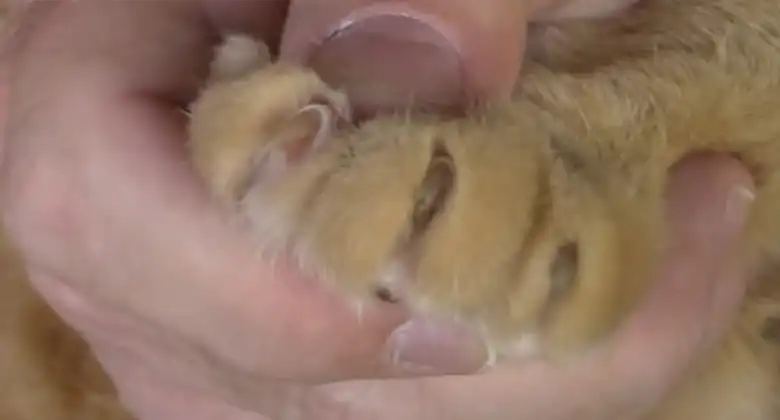Declawing is an increasingly controversial procedure, but cats who have already been declawed require special lifetime care. While declawing may seem convenient, it involves the amputation of each toe bone and carries risks. Caring for a declawed cat compassionately can help them live happily despite this permanent change.
The key is to provide gentle bedding, modified litter options, ramps, and stairs, appropriate toys, diligent health monitoring, and a safe indoor environment. With some minor adjustments to your home and routines, a declawed cat can feel comfortable, secure, and loved.
This article outlines the essentials for caring for a cat after declawing surgery, from pain management to playtime modifications. With a little patience and sensitivity, you can help your declawed cat thrive.

Tips to Care for a Declawed Cat
Declawing involves more than just removing a cat’s claws; it’s the amputation of the last bone of each toe. This procedure can lead to various physical and emotional challenges for your cat. Without their claws, cats may feel vulnerable, and they lose their primary defense mechanism. It’s crucial to recognize these changes and adapt your care accordingly.
So, here is how you can take care of your declawed cat:
- Monitor for Post-Surgery Pain
Since declawing removes the entire first toe bone, there is often chronic pain long after recovery. Watch for signs like:
- Limping or lameness
- Hesitation to jump up or down
- Excessive licking of paws
- Aggression or withdrawal
- Inappropriate urinating
Schedule regular vet exams to stay on top of pain management. Options like kitty NSAIDs or nutraceuticals can help keep your declawed cat comfortable.
- Provide Soft Bedding
Cushion declawed paws with plush blankets and pet beds. Avoid wire bottoms or hard surfaces that put pressure on sensitive paw tips. Massage and light brushing can also relax sore joints.
Give cats places to perch up high they can access without jumping. Install ramps and steps to reach windows, furniture, and cat trees safely.
- Use Cat-Friendly Litter
Rough litters can bother healing paws after surgery. Use extra soft clumping litter instead. Scoop waste daily to keep boxes clean. Place boxes in easy-access areas of your home.
- Try Different Litter Boxes
Experiment with lower-sided, larger boxes that are easy to enter and exit. Scatter mats outside catch loose granules. Self-cleaning boxes may be ideal, but keep them hygienic. Find the style your individual litter Box cat prefers.
- Discourage Jumping
Restrict access to high perches and outdoor roaming to prevent injuries. Use pet stairs/ramps until cats learn to navigate gently on tender paws. Stop risky jumping and falls while they heal.
- Provide Interactive Toys
Wand toys allow cats to playfully hunt without stressing their paws. Food puzzles encourage mental stimulation too. Avoid toys that lead to sudden sprints or stops. Prioritize gentler mouth play.
- Consult Your Vet First
Before making significant diet or lifestyle changes, see your vet for guidance tailored to your cat. Get their input on appropriate activity levels, nutritional supplements, paw pad protectants, and more.
What are the Impacts of Declawing a Cat?
Declawing is not just removing nails, it is the amputation of the last bone of each toe. This has lifelong physical and behavioral impacts:
- Shortened, deformed feet
- Chronic pain or nerve damage
- Impaired balance and mobility
- Stress and anxiety
- Aggression or biting
- Failure to use the litter box
- Excessive grooming habits
- Emotional distress
Cats rely on their claws for balance, climbing, stretching, kneading, and self-defense. Removal of claws alters natural behavior. Some impacts may be irreversible even with special care.
Conclusion
While controversial, declawing is irreversible, so cats already declawed deserve special care. With some thoughtful adjustments to bedding, litter, toys, and your home setup, you can support your cat’s health and happiness despite declawing. Don’t be afraid to ask your vet questions. With time and patience, your cat can thrive after surgery.
FAQs
Do Declawed Cats Need Special Litter?
Yes, super soft, clumping litters are best. Avoid rough or crystalline options that can further irritate healing paws.
Why Might My Declawed Cat Stop Using The Litter Box?
Discomfort, stress, or dislike of litter texture could be reasons. Try more boxes with very soft litter. See your vet.
How Can I Make My Home Declaw-Friendly?
Use ramps, keep cats indoors only, provide soft beds up high, put down mats by litter boxes, and get interactive wand toys.
Are There Alternatives To Declawing?
Yes! Try regular nail trims, scratching posts, cat-friendly furniture spray, plastic caps on nails, and positive reinforcement.
What Are Signs Of Pain In A Declawed Cat?
Limping, biting, aggression, inappropriate urination, paw licking, hesitating to jump, and overall changes in behavior can indicate pain.
